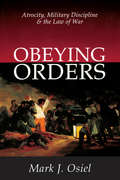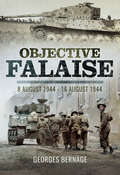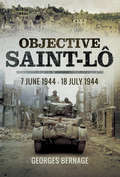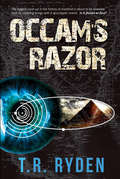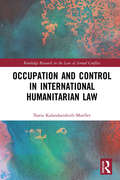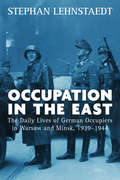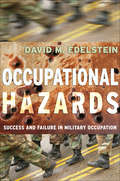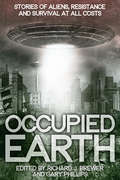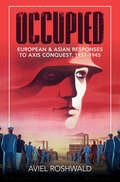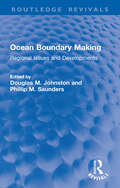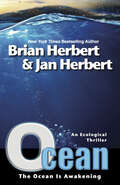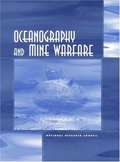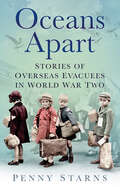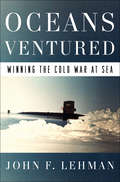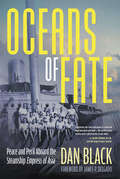- Table View
- List View
Obeying Orders: Atrocity, Military Discipline and the Law of War
by Mark J. OsielA soldier obeys illegal orders, thinking them lawful. When should we excuse his misconduct as based in reasonable error? How can courts convincingly convict the soldier's superior officer when, after Nuremberg, criminal orders are expressed through winks and nods, hints and insinuations? Can our notions of the soldier's "due obedience," designed for the Roman legionnaire, be brought into closer harmony with current understandings of military conflict in the contemporary world? Mark J. Osiel answers these questions in light of new learning about atrocity and combat cohesion, as well as changes in warfare and the nature of military conflict. Sources of atrocity are far more varied than current law assumes, and such variations display consistent patterns. The law now generally requires that soldiers resolve all doubts about the legality of a superior's order in favor of obedience. It excuses compliance with an illegal order unless the illegality - as with flagrant atrocities - would be immediately obvious to anyone. But these criteria are often in conflict and at odds with the law's underlying principles and policies. Combat and peace operations now depend more on tactical imagination, self-discipline, and loyalty to immediate comrades than on immediate, unreflective adherence to the letter of superiors' orders, backed by threat of formal punishment. The objective of military law is to encourage deliberative judgment. This can be done, Osiel suggests, in ways that enhance the accountability of our military forces, in both peace operations and more traditional conflicts, while maintaining their effectiveness. Osiel seeks to "civilianize" military law while building on soldiers' own internal ideals of professional virtuousness. He returns to the ancient ideal of martial honor, reinterpreting it in light of new conditions, arguing that it should be implemented through realistic training in which legal counsel plays an enlarged role rather than by threat of legal prosecution. Obeying Orders thus offers a compelling answer to the question that has most haunted the moral imagination of the late twentieth century: the roots - and restraint - of mass atrocity in war.
Objective Falaise: 8 August 1944–16 August 1944
by Georges BernageOn the night of 8 August 1944, the First Canadian Army launched Operation Totalize, directing their advance towards Falaise, with the intention of breaking through the German defences south of Caen. In spite of large numbers, they were halted by the 12.SS- Panzer-Division "Hitierjugend", who managed to block the 600 armored vehicles. During one of the German counter-attacks, several Tiger tanks were destroyed, including that of panzer ace, Michael Wittmann, who was killed in the process.The offensive was relaunched a few days later under the name Operation Tractable, the intention this time being to capture the strategically important town of Falaise and close the 'Falaise Pocket', also known as the 'Corridor of Death'.This book provides the reader with a day-by-day account of this forgotten battle, while also acting as a field guide, including maps and both comtemporary and modern photographs.
Objective Saint-Lô: 7 June 1944–18 July 1944
by Georges Bernage&“A collection of eyewitness accounts of the heavy fighting that took place in this part of France after the Omaha landings . . . excellent and gripping.&”—FSAddon This book provides a day-by-day account of the forty-two days of fighting from Omaha Beach to Saint-Lô. Follow Lt. Allsup from the beaches at Hill 108 (the &“bloody hill&”), where he was injured, and Lt. Jones, who was among the first to enter Saint-Lô; a town destroyed by bombs, which was to become the graveyard of hundreds of Normans. On the opposing side, discover the fate of the fearsome &“green devil&” paratroopers of General Schimpf and follow in the footsteps of paratroopers Erwin Schmieger and Rudi Frühbeisser, as they defend their armed camp, ensuring that every hedge will only be taken at the highest price. Objective Saint-Lô takes the reader along the little or unknown routes from the horrors of Omaha Beach to Trvires, La Cambe, Isigny, through the Aure valley to Hill 108, (&“Purple Heart Hill&”) and Hills 192 and 122. As well as authentic eyewitness testimony, the book also acts as a field guide, including maps and both contemporary and modern photographs. &“Lavishly illustrated with sketch maps, then and now images and numerous personal accounts from US and German sources, this is an excellent campaign overview, ideal for tour planning.&”—Guild of Battlefield Guides &“An exciting story with insights from those who were there and an amazing collection of photographs, drawing and maps—Highly Recommended.&”—Firetrench
Objects Of Translation: Material Culture And Medieval Hindu-Muslim Encounter
by Finbarr B. FloodObjects of Translation offers a nuanced approach to the entanglements of medieval elites in the regions that today comprise Afghanistan, Pakistan, and north India. The book--which ranges in time from the early eighth to the early thirteenth centuries--challenges existing narratives that cast the period as one of enduring hostility between monolithic "Hindu" and "Muslim" cultures. These narratives of conflict have generally depended upon premodern texts for their understanding of the past. By contrast, this book considers the role of material culture and highlights how objects such as coins, dress, monuments, paintings, and sculptures mediated diverse modes of encounter during a critical but neglected period in South Asian history. The book explores modes of circulation--among them looting, gifting, and trade--through which artisans and artifacts traveled, remapping cultural boundaries usually imagined as stable and static. It analyzes the relationship between mobility and practices of cultural translation, and the role of both in the emergence of complex transcultural identities. Among the subjects discussed are the rendering of Arabic sacred texts in Sanskrit on Indian coins, the adoption of Turko-Persian dress by Buddhist rulers, the work of Indian stone masons in Afghanistan, and the incorporation of carvings from Hindu and Jain temples in early Indian mosques. Objects of Translation draws upon contemporary theories of cosmopolitanism and globalization to argue for radically new approaches to the cultural geography of premodern South Asia and the Islamic world.
Objects of War: The Material Culture of Conflict and Displacement
by Tara Zahra Leora AuslanderHistorians have become increasingly interested in material culture as both a category of analysis and as a teaching tool. And yet the profession tends to be suspicious of things; words are its stock-in-trade. What new insights can historians gain about the past by thinking about things? A central object (and consequence) of modern warfare is the radical destruction and transformation of the material world. And yet we know little about the role of material culture in the history of war and forced displacement: objects carried in flight; objects stolen on battlefields; objects expropriated, reappropriated, and remembered.Objects of War illuminates the ways in which people have used things to grapple with the social, cultural, and psychological upheavals wrought by war and forced displacement. Chapters consider theft and pillaging as strategies of conquest; soldiers' relationships with their weapons; and the use of clothing and domestic goods by prisoners of war, extermination camp inmates, freed people, and refugees to make claims and to create a kind of normalcy.While studies of migration and material culture have proliferated in recent years, as have histories of the Napoleonic, colonial, World Wars, and postcolonial wars, few have focused on the movement of people and things in times of war across two centuries. This focus, in combination with a broad temporal canvas, serves historians and others well as they seek to push beyond the written word.Contributors:Noah Benninga, Sandra H. Dudley, Bonnie Effros, Cathleen M. Giustino, Alice Goff, Gerdien Jonker, Aubrey Pomerance, Iris Rachamimov, Brandon M. Schechter, Jeffrey Wallen, and Sarah Jones Weicksel
Objetivo prioritario
by Héctor Jonathan P. BrazeeUn relato breve sobre la sargento primera Gracie Medicine Crow, perteneciente a la Federación del Cuerpo de Marines
Obras completas (Anne Frank)
by Anne FrankUna recopilación magistral que contextualiza la importancia que tuvo la escritura para la supervivencia física y espiritual de Anne Frank, y talla sus palabras en la memoria. El Diario de Anne Frank es una de las lecturas más conocidas sobre la Segunda Guerra Mundial y, gracias a él, la memoria de su protagonista sigue más vigente que nunca. Cientos de miles de personas visitan cada año el museo de la Casa de Anne Frank, en Ámsterdam, para ver dónde la niña y su familia se escondieron de las fuerzas de la ocupación alemana hasta que fueron enviados a Auschwitz en 1944. El único miembro de la familia que sobrevivió al Holocausto fue el padre de Anne, Otto Frank. Estas Obras completas reúnen diversas versiones del diario de Anne, incluida la canónica, editada por la traductora y autora Mirjam Pressler, además de material inédito como cartas, reflexiones, ensayos o las citas favoritas de su protagonista. Este volumen también contiene textos de reputados historiadores sobre asuntos como «La vida de Anne Frank», «La historia de la familia de Anne Frank» y «La historia de la recepción del diario», así como numerosas fotografías de los Frank y del resto de habitantes del escondite. Para conmemorar el 75 aniversario de la primera publicación del Diario, Plaza & Janés brinda a los lectores esta recopilación de los escritos de la joven, con el apoyo del Fondo Anne Frank, que su padre, Otto, estableció para salvaguardar el legado de su hija. Una lectura esencial tanto para los expertos como para el gran público ya que recoge, por primera vez, todos los escritos de Anne Frank además de material adicional que ofrecerá una profundidad nueva a su lectura.
Observers from Abroad: Twentieth Century Western Documentary Photography in the USSR (Routledge Histories of Central and Eastern Europe)
by Martin A. MillerObservers from Abroad offers an examination of published and archival images of Soviet Russia, providing a deeper understanding of the complexities and vicissitudes of its political culture.The book argues that photography, when accurately interpreted, can be utilized as primary historical evidence that has the potential to both enhance and counter traditional verbal analysis. Employing a number of images of the Soviet Union captured by gifted documentary photographers from the West, who received visas to work in Moscow from the Bolshevik seizure of power in 1917 to the collapse of the USSR in 1991, the book also assesses the intentions of the photographers, who acted as conscious observers capturing visual evidence under the restraining conditions of state surveillance. Each chapter provides a closer look at the life and work of these photographers, with a wealth of historical images and discussion.Richly illustrated and engaging, this volume will be ideal for students, scholars, and readers interested in Soviet history, twentieth century history, and the history of photography.
Obtaining Life-Cycle Cost-Effective Facilities in the Department of Defense
by Clifford A. Grammich Katharine Watkins Webb Constantine Samaras Abigail HaddadThe Department of Defense (DoD) constructs, operates, and maintains a large number of facilities. DoD incorporates life-cycle cost-effective practices into many aspects of the military planning and construction processes. This report provides RAND’s description and assessment of the process used to obtain life-cycle cost-effective facilities and how that affects DoD construction options and choices.
Occam's Razor
by T. R. RydenWhen ancient artifacts discovered in the Great Pyramid of Giza shed new light on a DNA pattern identified by a world-renowned molecular biologist, venture capitalist, James Anderson, is thrust into an action-packed road of scientific exploration and discovery. An unlikely participant in the events that begin to unfold, Anderson and his team, pursued by those who don’t want this new information out, realize they have stumbled upon the greatest and most terrifying cover-up in the history of the human race.Occam’s Razor is a chilling speculative fiction thriller which ties together several well-known, and some not so famous controversial theories concerning alien visitation, human evolution, ancient legends, and the cosmos. The novel explains how it could be very plausible to imagine that the powers that be may already know about an impending disaster and caught between all this are the novel’s unfortunate characters as they struggle to figure out what to do in the face of unstoppable catastrophe.
Occupation and Control in International Humanitarian Law (Routledge Research in the Law of Armed Conflict)
by Natia Kalandarishvili-MuellerThis book presents a systematic analysis of the notion of control in the law of military occupation. The work demonstrates that in present-day occupations, control as such occurs in different forms and variations. The polymorphic features of occupation can be seen in the way states establish control over territory either directly or indirectly, and in the manner in which they retain, relinquish or regain it. The question as to what level and type of control is needed to determine the existence and ending of military occupation is explored in great detail in light of various international humanitarian law instruments. The book provides an anatomy of the required tests of control in determining the existence of military occupation based on the law. It also discusses control in relation to occupation by proxy and when and how the end of control over territory occurs so that military occupation is considered terminated. The study is informed by relevant international jurisprudence. It draws on numerous pertinent case studies from all over the world, various reports by different UN entities and other international organisations, as well as legal doctrine. The book will be a valuable resource for academics, researchers and practitioners working in the fields of international humanitarian law, international public law, and security studies
Occupation in the East: The Daily Lives of German Occupiers in Warsaw and Minsk, 1939-1944
by Stephan LehnstaedtFollowing their occupation by the Third Reich, Warsaw and Minsk became home to tens of thousands of Germans. In this exhaustive study, Stephan Lehnstaedt provides a nuanced, eye-opening portrait of the lives of these men and women, who constituted a surprisingly diverse population—including everyone from SS officers to civil servants, as well as ethnically German city residents—united in its self-conception as a “master race.” Even as they acclimated to the daily routines and tedium of life in the East, many Germans engaged in acts of shocking brutality against Poles, Belarusians, and Jews, while social conditions became increasingly conducive to systematic mass murder.
Occupational Hazards: Success and Failure in Military Occupation (Cornell Studies in Security Affairs)
by David M. EdelsteinFew would contest that the U.S. occupation of Iraq is a clear example of just how fraught a military occupation can become. In Occupational Hazards, David M. Edelstein elucidates the occasional successes of military occupations and their more frequent failures. Edelstein has identified twenty-six cases since 1815 in which an outside power seized control of a territory where the occupying party had no long-term claim on sovereignty. In a book that has implications for present-day policy, he draws evidence from such historical cases as well as from four current occupations—Bosnia, Kosovo, Afghanistan, and Iraq—where the outcome is not yet known. Occupation is difficult, in Edelstein's view, because ambitious goals require considerable time and resources, yet both the occupied population and the occupying power want occupation to end quickly and inexpensively; in drawn-out occupations, impatience grows and resources dwindle. This combination sabotages the occupying power's ability to accomplish two tasks: convince an occupied population to suppress its nationalist desires and sustain its own commitment to the occupation. Structural conditions and strategic choices play crucial roles in the success or failure of an occupation. In describing those factors, Edelstein prescribes a course of action for the future.
Occupied Earth
by Richard Brewer Gary PhillipsRESISTANCE IS ALLFor years, writers and filmmakers have speculated about the possibility of the Earth being invaded by aliens from another planet. But what if the aliens have been watching us, infiltrating us via human collaborators, or even surgically altering themselves to look human?Occupied Earth is a groundbreaking anthology that explores the idea of what the world would look like years after its conquest. 20 years after a successful invasion by the Makh-Ra, humanity still exists, only it has become subservient to a race of occupiers who govern the devastated planet. But, as much at things continue with some sense of normalcy, something has happened in the Mahk-Ra's empire. Earth, once considered a strategic beachhead of major importance to the Empire, has been downgraded in its value. Things are starting to degrade. Our planet is the last place any self-respecting Mahk-Ra officer wants to be assigned. Yet, despite everything, life continues.These stories bring us face to face with annihilation - and show how we can pull ourselves back from the brink. Featuring Rachel Howzell Hall, Lisa Morton, Matthew V. Clemens, Howard Hendrix, Nathan Walpow and more, OCCUPIED EARTH is coming. Stay safe. Stay strong. Survive at all costs.
Occupied: European and Asian Responses to Axis Conquest, 1937–1945
by Aviel RoshwaldFor most of the population of Europe and East and Southeast Asia, the most persistent and significant aspect of their experience of the Second World War was that of occupation by one or more of the Axis powers. In this ambitious and wide-ranging study, Aviel Roshwald brings us the first single-authored, comparative treatment of European and Asian responses to German and Japanese occupation during the war. He illustrates how patriotic, ethno-national, and internationalist identities were manipulated, exploited, reconstructed and reinvented as a result of the wholesale dismantling of states and redrawing of borders. Using eleven case studies from across the two continents, he examines how behavioral choices around collaboration and resistance were conditioned by existing identities or loyalties as well as by short-term cost–benefit calculations, opportunism, or coercion.
Occupying Iraq: A History of the Coalition Provisional Authority
by James Dobbins Seth G. Jones Benjamin Runkle Siddharth MohandasFocuses on the activities of the Coalition Provisional Authority during the first year of the occupation of Iraq. Based on interviews and nearly 100,000 never-before-released documents from CPA archives, the book recounts and evaluates the efforts of the United States and its coalition partners to restore public services, counter a burgeoning insurgency, and create the basis for representative government.
Ocean Boundary Making: Regional Issues and Developments (Routledge Revivals)
by Douglas M. Johnston Phillip M. SaundersOriginally published in 1988, this book was written at a time when many nations were engaged in various forms of ocean boundary making. This created new regional pressures and the need for collective regional responses to these issues. This book examines the issues at stake and the boundary making processes. It discusses these in a general way, showing how the Third UN conference on the Law of the Sea helped resolve the problems whilst leaving some issues unresolved. The book goes onto examine the issues and boundary making processes in 7 important areas of the world
Ocean: The Ocean Cycle Omnibus
by Brian Herbert Jan HerbertFrom a New York Times–bestselling author, an ecological thriller about human animal hybrids battling to rescue the ocean from environmental impact. In 2024, Earth is consumed by a great War of Ocean Liberation: a military force of sea creatures attacks naval installations, shuts down shipping lanes and fishing operations, and destroys offshore oil-drilling rigs. Huge blue whales, sharks, dolphins, and even monstrous creatures thought to be extinct—all strike with ferocity and surprising strength. The marine armada is led by hybrid, transformed humans who call themselves Sea Warriors, ocean-rights zealots who can swim to the deepest regions of the sea and live off the bounty of the waters. Their commander, Kimo Pohaku, announces his startling intention: The complete liberation of the seas from human control. Finally, the ocean is fighting back, but it might be too late . . .
Oceanography And Mine Warfare
by National Research CouncilBased on a 1999 symposium, this report reviews how oceanographic data are used in US mine warfare, and the current and future capability of research to enhance such operations. Coverage includes doctrine, training issues, data collection/database capabilities, and modeling capabilities. Appends information on the symposium, a wargame scenario, the Office of Naval Research Program, and supporting research programs. Lacks an index. Annotation c. Book News, Inc. , Portland, OR (booknews. com)
Oceans Apart: Stories of Overseas Evacuees in World War Two
by Penny StarnsFrom May 1940, the Children’s Overseas Reception Board began to move children to Australia, South Africa, Canada and New Zealand for their own safety during the Second World War. The scheme was extremely popular, and over 200,000 applications were made within just four months, while thousands of children were also sent to be privately evacuated overseas. The ‘sea-vacs’, as they became known, had a variety of experiences.After weeks at sea, they began new lives thousands of miles away. Letters home took up to twelve weeks to reach their destination, and many children were totally cut off from their families in the UK. While most were well cared for, others found their time abroad a miserable, difficult or frightening experience as they encountered homesickness, prejudice and even abuse.Using a range of primary source material, including diaries, letters and interviews, Penny Starns reveals in heart-breaking detail the unique and personal experiences of sea-vacs, as well as their surprising influence on international wartime policy in their power to elicit international sympathy and financial support for the British war effort.
Oceans Ventured: Winning The Cold War At Sea
by John LehmanA thrilling story of the Cold War, told by a former navy secretary on the basis of recently declassified documents. When Ronald Reagan took office in January 1981, the United States and NATO were losing the Cold War. The USSR had superiority in conventional weapons and manpower in Europe, and had embarked on a massive program to gain naval preeminence. But Reagan already had a plan to end the Cold War without armed conflict. Reagan led a bipartisan Congress to restore American command of the seas by building the navy back to six hundred major ships and fifteen aircraft carriers. He adopted a bold new strategy to deploy the growing fleet to northern waters around the periphery of the Soviet Union and demonstrate that the NATO fleet could sink Soviet submarines, defeat Soviet bomber and missile forces, and strike aggressively deep into the Soviet homeland if the USSR attacked NATO in Central Europe. New technology in radars, sensors, and electronic warfare made ghosts of American submarines and surface fleets. The United States proved that it could effectively operate carriers and aircraft in the ice and storms of Arctic waters, which no other navy had attempted. The Soviets, suffocated by this naval strategy, were forced to bankrupt their economy trying to keep pace. Shortly thereafter the Berlin Wall fell, and the USSR disbanded. In Oceans Ventured, John Lehman reveals for the first time the untold story of the naval operations that played a major role in winning the Cold War.
Oceans of Fate: Peace and Peril Aboard the Steamship Empress of Asia
by Dan BlackThe remarkable story of how one ship — doomed by war — intersected lives and crossed into history. Completed in 1913 for Canadian Pacific, the Empress of Asia plied the oceans for nearly 30 years. Built for long-haul ocean travel during peace-time, she saw wartime service as an armed merchant cruiser and troopship before Japanese dive-bombers destroyed her in 1942. Through the Roaring Twenties and the Great Depression, she brought continents and people together, delivering mail and multimillion-dollar consignments of silk. As a luxurious passenger liner, she was a “Greyhound of the Pacific,” braving epic storms and smashing transpacific speed records. From stokehold to bridge, steerage to first-class staterooms, she steamed with a kaleidoscope of lives, including courageous and recalcitrant crew, immigrants and refugees seeking a better life or relief from disaster, drug smugglers, weapons dealers, and the idle and not-so-idle rich. This is the dramatic story of how that one ship and the lives of those on board intersected during a tumultuous period of world history, culminating in her sinking off Singapore in the Second World War.
Oceans of Fire (Stony Man #86)
by Don PendletonStony Man is the last line of defense in a new age of terror. The covert ops teams that make up the clandestine anti-terrorist group are the elite in the field. Backed by superior cybernetic and real-time intelligence, the men of Phoenix Force and Able Team strike with relentless precision, fighting the worst the world has to offer, whenever and wherever it leads them. The trail to recapture stolen Russian nukes puts Stony Man on a mission that's turning suicidal. Using covert and hardball tactics, the nukes are traced to a source inside the Middle East, but it's soon discovered that the Arab extremists are merely financiers in an operation laced with wrong turns, double dealings and the changing face of an enemy clever enough to stay one step ahead. Stony Man is up against a deadly chimera: Russian mafiya, Afghan warlords and a mysterious German corporate magnate whose desire for revenge threatens to wipe America's eastern seaboard off the map.
Oceans, Seas, Shorelines and Warfare (Oceans, Seas, and Shorelines)
by Ross Anderson Richard Harding Mick de RuyterFor as long as humanity has ventured on the seas, naval warfare has been an integral part of their activities and the focal point for many histories and ideas of heritage. This book presents a rarely explored aspect: the long‑term impact of those battles on shorelines, seas and oceans.Dramatic and altering, the physical scars of battles remain with us today in the form of cultural landscapes and archaeological sites, while the geopolitical consequences of warfare have been world‑changing. The migrations of peoples across the seas, accompanied by violence, have done more to shape the demographic and cultural map of the modern world than almost anything else. Both seaborne opportunities and threats have influenced the way of life of coastal communities. Today, technology has seen these threats extend far into the deepest ocean and reach across continents. This book shows how, despite being virtually invisible to an increasing percentage of the world’s population, the ocean is more significant now than it has ever been.Ranging from the world of antiquity to the present day with a global perspective, the volume is intended to appeal to those interested in history, archaeology, social sciences and the environment.
Ocho días de mayo: De la muerte de Hitler al final del Tercer Reich
by Volker UllrichEl relato trepidante de los ocho días que cambiaron el rumbo del mundo. Uno de los mejores libros que se han escrito sobre la locura nazi. 30 de abril de 1945. En un búnker en las profundidades de la cancillería del Tercer Reich, Adolf Hitler y Eva Braun se suicidan. Pero la Alemania nazi sobrevive, la guerra no ha terminado. Todo parece detenerse y, sin embargo, todo se mueve a un ritmo frenético. Volker Ullrich relata jornada a jornada este tiempo fuera del tiempo y adentra al lector en un mundo que se derrumba, lleno de drama, violencia, esperanza y miedo.Los siguientes ocho días, entre los más turbulentos de la historia, fueron testigo de las batallas finales de la Segunda Guerra Mundial y el colapso de la Wehrmacht, pero también de las últimas marchas de la muerte, de una epidemia de suicidios y violaciones masivas, de los intentos fanáticos de una última resistencia, de la desesperada huida de los peces gordos nazis, de la liberación de los campos de concentración...En esta narración vibrante y conmovedora, el prestigioso historiador y periodista Volker Ullrich nos lleva al régimen fantasmagórico del almirante Karl Dönitz, sucesor de Hitler, que huye hacia Flensburgo mientras las fuerzas aliadas avanzan inexorablemente. Berlín capitula, el científico y diseñador de cohetes Wernher von Braun es detenido, Marlene Dietrich busca a su hermana en Bergen-Belsen. El relato de estos ocho días de mayo, basado en una asombrosa variedad de nuevas fuentes primarias y elaborado a partir de miniaturas históricas que forman un amplio mosaico, resulta más cautivador que muchas novelas de suspense. La crítica ha dicho:«Ullrich demuestra que los historiadores alemanes también saben escribir de forma elegante y cautivadora. Más emocionante que muchas novelas de suspense».Der Spiegel «Apasionante, impecablemente investigado».The Wall Street Journal «Excelente. Una síntesis admirable».The Times«Volker Ullrich ordena los hechos de tal manera que la lectura se convierte en un paseo histórico que ni resulta complaciente ni sermonea».Frankfurter Allgemeine Zeitung «Cautivador. Muestra adónde conducen la locura política y la decadencia moral, la violencia y la guerra».Frankfurter Rundschau «Un cambio de perspectiva revelador. Pocos serán los lectores que, aún creyendo conocer bien estos meses tan explorados, no se encuentren una y otra vez con detalles o episodios nuevos para ellos».Die Welt «Un libro vivo, de ritmo rápido y magníficamente investigado».The Spectator «Un relato vibrante de ocho días en los que toda Europa quedó suspendida en la confusión y el caos».Kirkus Reviews«La crónica brillante, cautivadora y a menudo inquietante de un momento surrealista de la historia».Publishers Weekly «Escrito con maestría».Library Journal «Un apasionante rompecabezas escénico».Der Spiegel«Inteligente y agudo. Un retrato vivaz basado en la observación precisa, el dominio de las fuentes y una mirada amplia».Süddeutsche Zeitung «Con un gran sentido de la narración, Ullrich funde los testimonios privados y la bibliografía histórica, las memorias y los archivos en una panorámica completa y muy lograda de un periodo tumultuoso».Die Tageszeitung «Ofrece fabulosas lecciones de historia para los tiempos actuales».Tagesspiegel «Un libro emocionante que nos deja casi sin aliento, y literalmente nos obliga a seguir leyendo».Stuttgarter Zeitung
